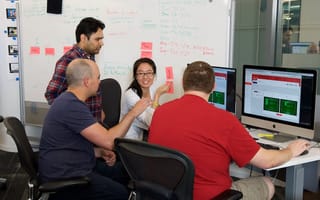What makes an idea worth pursuing past writing it down on a sticky note? How can you tell whether a concept has the weight, usefulness and marketability to be turned into a useful product or tool? And how do you refine that idea and turn it into a real product? We spoke to leaders at five tech companies to find out.

STATS offers its clients, which include sport teams and media companies, with data-based tools like player tracking and statistical post-game reports meant to improve in-game execution and fan engagement. Product Manager Jens Melvang said user input was a vital part of roadmapping its new soccer analytics product.
How did the idea for the new product come about?
Since the early start of match analysis in soccer, the main challenge has been how to describe soccer with a model that fits a coach’s perspective while giving real-time insights on how teams can improve their on-field performance. The challenge is very complex and requires a model that is not too technical. STATS’ artificial intelligence team managed to solve this problem by using AI in the solution, which is the foundation of the product.
It is important that research, engineering and design all work together.”
How did your team take that idea and turn it into a real product?
We went through a research phase, testing different scenarios of infrastructure as well as conducting extensive client interviews to understand what design would best suit the analysis process and workflow in soccer. By adding the AI component, we were able to provide real-time analysis, which we back up with video that coaches can access at the click of a button. Adding video was very important to a lot of the coaches we talked to
What’s the most interesting thing you or your team learned in the process?
Several things. It is important that research, engineering and design all work together in creating the solution, as it is all interdependent. We also learned that building the solution using a very agile and incremental approach is the best way to maximize market fit.

Snapsheet partners with insurance carriers to provide drivers with efficient mobile solutions, allowing them to file and settle claims quickly and virtually. Alex Meisner, director of innovation, said a core part of its product was born out of necessity.
How did the idea for the new product come about?
When Snapsheet launched in 2012, one of the core features of our product was the ability for the insurance carrier to pay their customers digitally. At the time, most insurance carriers could only issue paper checks. To offer this digital payment service, we partnered with a fintech company to provide the fund transfer. In 2015, the fintech company informed us they would be going out of business. Rather than cutting the payments service because we lost this vendor, we decided to build an in-house solution ourselves.
Great ideas come from solving both simple and complex problems that we experience every day.”
How did your team take that idea and turn it into a real product?
Since we had already created the underlying infrastructure for digital payments, we used that as a foundation. We immersed ourselves in the insurance carrier’s current state to understand their total loss payments process. Soon, we were implementing Snapsheet Transactions for multiple insurance carriers’ total loss payments. Then, a bank learned about our new solution and asked if we could team up to build out the functionality. After extensive research and collaboration, we created the new functionality and officially launched Snapsheet Transactions in October of 2017.
What’s the most interesting thing you or your team learned in the process?
As we continue to grow, it’s easy to get lost in possibilities, trends and ideas. Snapsheet Transactions helps to remind us that great ideas come from solving both simple and complex problems that we experience every day. In many ways, this means embracing change and using it as a launchpad to “be the next.” When in doubt, we stick to our roots and let our problem-solving nature lead the way.

RedShelf is an end-to-end digital distribution and online reading platform for educational reading materials. Product Manager Eric Hockman said a partner-first approach is what drives the company’s product design and implementation process.
How did the idea for the new product come about?
We always start with our partners in mind and ask, “What can we do to give them the best experience possible?” In the independent bookstore industry, the adoption process is an integral part of their ability to do business as it’s a required first step before they can procure content. We saw a shortcoming in the market with a lack of flexible and efficient adoption tools and wanted to rectify the situation.
Building a tool to accommodate as many needs as possible, even when those needs conflict, was an interesting challenge.”
How did your team take that idea and turn it into a real product?
The ideation phase started with conversations with our bookstore partners to figure out what they needed. We then made an outline of actionable features to build and worked hard to find the balance between meeting all the bookstore needs and being conscious of development time in order to get a first iteration of the product to our partners. We tried to make sure we were open to changes and new requirements as to not lock ourselves into specific ideas too early on.
What’s the most interesting thing you or your team learned in the process?
Every school does things a bit differently, so building a tool to accommodate as many needs as possible, even when those needs conflict, was an interesting challenge. We learned, and are still learning, how to find that balance between competing needs within an industry and product.

Opternative provides online vision tests a consumer can take from a mobile device, before submitting their results to an ophthalmologist and receiving a prescription. Chief Technology Officer Ayo Jimoh said taking risks has been a key part of the company’s product development process.
How did the idea for your product come about?
In 2012, our founder Steven Lee was practicing Optometry in Chicago. One of his patients who frequently missed appointments asked him, “Why can’t I just do this at home?” That moment was the genesis of a series of events that created Opternative.
We couldn’t be afraid of failure as we went through dozens of iterations and prototypes.”
How did your team take that idea and turn it into a real product?
We built a great team and dug into research and product development. In our early stages, everyone was a member of the product team and involved in the process of ideation, prototyping and user testing. Roughly 75 percent of our employee base wore corrective eyewear, so as soon as a new prototype was ready, we ran everyone on the team through it to test efficacy. This process created a blazingly fast feedback loop to narrow down what worked and what didn’t in order to build our online vision test.
What’s the most interesting thing you or your team learned in the process?
We learned that we couldn’t be afraid of failure as we went through dozens of iterations and prototypes. While everything we’ve built was based on fundamental optical principles, there was no textbook on how to build an online vision test. It took grit, tenacity and acceptance that most of our hypotheses and prototypes would turn out wrong in the beginning.

Screencastify develops an in-browser tool for Google Chrome that allows users to record actions on their screens and share recordings with others. Manuel Braun, founder and chief technology officer, said filling a supply vacuum was a key part of the decision to create their core product.
How did the idea for the new product come about?
There are nearly endless reasons why someone would want to record their computer screen: instructional videos, product demos, UX, gaming, student assessments and UFO chasing — which is a real use case we’ve seen. But historically, screen recording software has been bulky, complicated and really expensive. We identified a major disconnect in supply and demand here — tons of people wanted to create screen recordings, but could not.
The people who depend on our product every day know it on a more meaningful level than we do.”
How did your team take that idea and turn it into a real product?
We noticed that Google Chrome had recently given more flexibility to its extensions, which would, for the first time ever, allow screen recording without downloading software. At the same time, Chromebooks were growing in popularity in the K-12 education world. Since Chromebooks don’t allow software downloads, these devices were a perfect target for us. Also gaining steam was the “flipped classroom” model, which let students learn at home by watching videos their teachers made. So we identified both our technical opportunity and our niche.
What’s the most interesting thing you or your team learned in the process?
The best features of Screencastify came from the minds of our users and are things that we never would have dreamt up. The people who depend on our product every day know it on a more meaningful level than we do. It’s so easy to get caught up in your own product and convince yourself that the way you view it is the right way or the only way.











